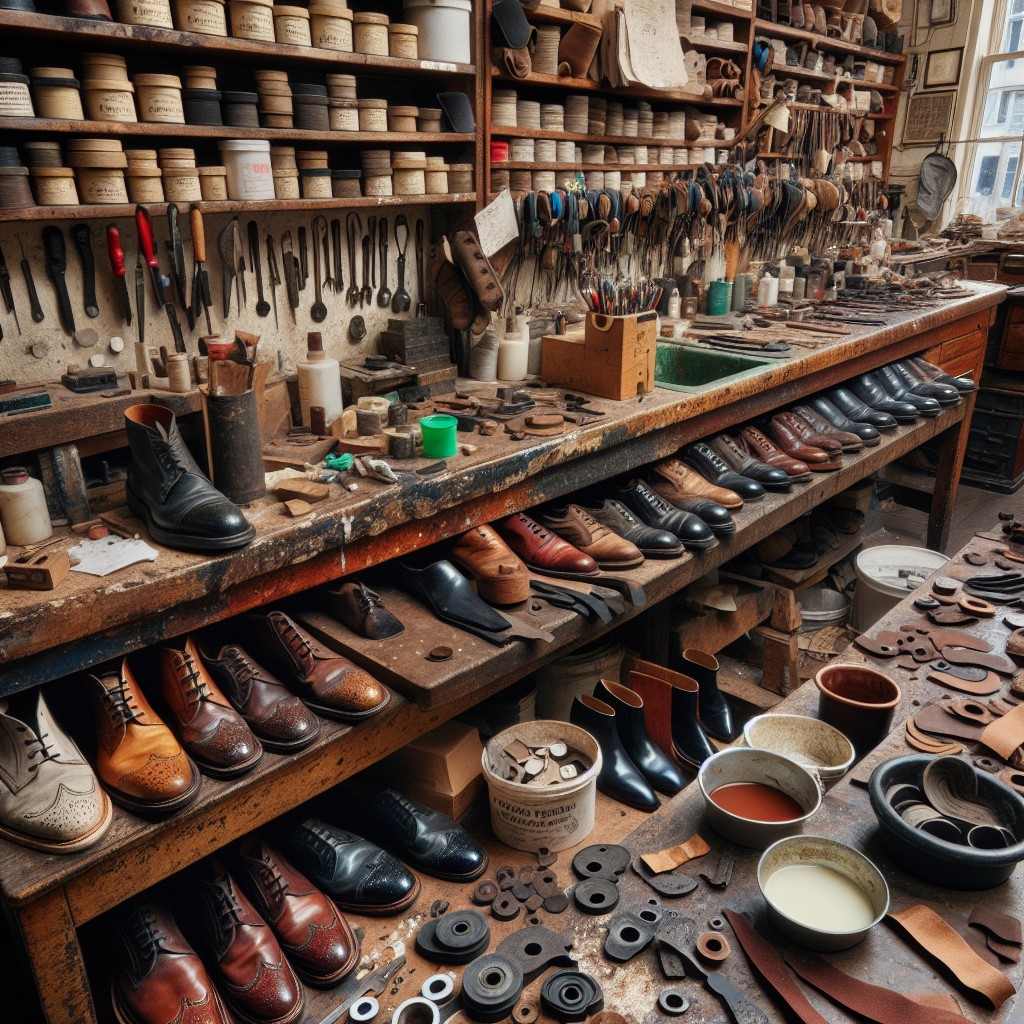Last updated on
Unlock the secrets of the top boot repair shops in New York City because your favorite boots deserve nothing but the best care and attention.
Key takeaways:
- Caring for boots through regular repair extends their lifespan.
- Common boot repairs include sole replacement, heel repair, and stitching.
- Choose a boot repair shop with experience, quality materials, and good reviews.
- Promptly seek professional assistance for worn-down soles, damaged heels, etc.
- Boot repair costs vary based on the type and extent of repair needed.
Table of Contents
Importance of Boot Repair

Caring for boots through regular repair extends their life exponentially, often making the difference between a pair that lasts a season versus several years. It’s a sustainable choice, reducing the need to buy new pairs and thus limiting waste. Additionally, well-maintained boots maintain their comfort and support, which is vital for those who wear them daily.
For individuals who have invested in high-quality or custom boots, repairs can preserve the craftsmanship and design that attracted them to the pair in the first place. Lastly, safety can be a concern, particularly with work or outdoor boots; maintaining good traction with sole repairs, for instance, is crucial.
Types of Boot Repairs

Sole Replacement is a common service where worn or damaged soles are removed and new ones are attached. This extends the life of the boots and improves comfort.
Heel Repair involves rebuilding or replacing the heel of the boot, ideal for those who have worn down one side due to their walking style. It restores balance and prevents further damage to the boots.
Stitching and Patchwork address tears or separations in the material. Using strong threads and patches, a cobbler can restore the integrity of the boots, preventing small issues from becoming major problems.
For waterproof or specialty boots, additional services like waterproofing treatments and hardware replacement, such as eyelets or hooks, may also be available. Each repair ensures your boots remain durable and functional for all your needs.
Sole Replacement

Replacing worn or damaged soles is a fundamental service offered by boot repair shops to extend the life of your boots. A new sole can rejuvenate an old pair of boots, improving both comfort and traction.
During this process, the old sole is removed, and a new one is attached using specialized adhesives or stitching, depending on the boot’s construction. Varieties of new soles include rubber for durability and grip, leather for breathability and formal appearance, or composite materials for a balance of features.
It’s essential to choose a sole that matches your needs – consider the environment you’ll be in and the level of comfort you expect. Proper sole replacement can also offer improved arch support through custom orthopedic insoles, which can be integrated into the new sole.
Remember, the quality of materials and craftsmanship will directly impact the end result, so select a repair shop with expertise in sole replacement.
Heel Repair

Heel repair revitalizes the supportive structure of the boot that endures significant wear and tear. Over time, the heel can break, wear down unevenly or become detached. A skilled cobbler will assess the damage and either reattach the existing heel securely, replace it with a new one that matches the boot’s original appearance, or add a rubber heel cap for added protection.
For high-heeled boots, the dowel — the central pin that supports the heel — may also need replacing to ensure stability and prevent future breaks. Prompt attention to heel issues not only extends the life of your boots but also maintains comfort and posture.
Stitching and Patchwork
Repairing tears and rips in your boots not only restores their functionality but also extends their lifespan considerably. Skilled cobblers use heavy-duty thread to ensure that the stitching withstands daily wear and strain.
When a boot has suffered a puncture or a sliced upper, a patch may be necessary. Craftsmen carefully select a material that matches the original boot’s look and feel, providing a seamless fix.
These restorative techniques prevent small damages from becoming costly problems, an investment in both the boot’s aesthetic and durability.
Regular check-ups can catch early signs of wear, saving you from more extensive repairs down the line.
Identifying a Quality Boot Repair Shop
When scrutinizing potential boot repair shops, consider the following factors to ensure high-quality service:
- Experience: A long-standing establishment often indicates skilled cobblers who have honed their craft over time.
- Materials: Quality shops invest in premium materials, signifying durable repairs; inquire about the types of leather, soles, and adhesives used.
- Reviews and Testimonials: Customer feedback, whether through online reviews or word-of-mouth, reflects the shop’s reliability and customer service.
- Services Offered: Comprehensive care including polishing, conditioning, and waterproofing, hints at a shop’s expertise beyond basic repairs.
- Turnaround Time: Efficient services are important, but beware of those that promise unrealistically quick repairs, which may compromise quality.
- Warranty: A warranty or guarantee on repairs shows the shop stands behind its work, offering you peace of mind.
Observing a cobbler’s workspace can also be informative—tidiness and organization suggest professionalism and attentiveness to detail.
When to Seek Professional Boot Repair
Recognizing the right time to visit a boot repair shop can extend the life of your footwear significantly. Proactive measures often save you from larger, more costly problems down the road. Here are a few indicators that it’s time for professional assistance:
- Worn-down soles: If you start to lose the tread on your boots or develop holes, it’s time to consider sole replacement.
- Damaged heels: Uneven heel wear can lead to posture issues. Repairing or replacing a heel is essential to maintain alignment.
- Leaking boots: Water seeping in indicates a breach in waterproofing or a tear in the material, which necessitates a swift repair.
- Separating seams: To prevent further unraveling or loss of structural integrity, any noticeable seam damage should be mended by a cobbler.
- Persistent discomfort: If your once comfortable boots now cause pain or blisters, the inner structure may need repair.
Addressing these issues promptly can not only restore your boots to their former glory but also assure many more years of dependable wear.
Cost Factors in Boot Repair
Understanding the pricing for boot repair services is crucial for setting expectations and budgeting accordingly. Costs can vary significantly based on the type and extent of the repair needed.
Simple fixes like minor stitching or patching tend to be less expensive, often costing under $30. More complex repairs such as a full sole replacement can be more costly, potentially exceeding $75, depending on the materials and labor involved.
The quality of the boot itself also influences the cost; high-end boots may require specialized handling, driving up the repair price. Additionally, local market rates and the expertise of the cobbler are factors that will affect the final cost.
It’s worth noting that preventative maintenance can reduce the frequency and cost of repairs down the line, so investing in quality care products might save money in the long run. Always ask for a detailed quote upfront to avoid surprises and ensure the repair is worth the investment compared to the cost of a new pair.
Estimated Time for Boot Repairs
Estimating repair time depends on the specific issue and the boot repair shop’s workload. For minor repairs like scuffs or small stitching fixes, you might get your boots back within a day or two. More involved services, such as sole replacement or leather conditioning, could take a week or more, particularly if there’s a queue of orders. Seasonal peaks, such as winter or hiking season, can also extend wait times. If time is of the essence, ask if the shop offers an expedited service option. Always check with your cobbler for a time estimate when you drop off your boots to align expectations.
Maintenance Tips Post Boot Repair
To ensure your boots remain in top condition after a repair, follow these maintenance tips:
- Condition Regularly: Leather boots require conditioning to stay supple and prevent cracking. Use a quality leather conditioner every few months or as needed based on wear.
- Proper Cleaning: Remove dirt and debris after each use with a soft brush or damp cloth. For deep cleaning, use products designed for the specific material of your boots.
- Avoid Wet Conditions: If possible, avoid wearing your boots in wet conditions. However, if they do get wet, let them air dry away from direct heat sources to prevent the material from warping.
- Use Supportive Inserts: Protect the shape and structure of your boots by using supportive shoe inserts or a boot shaper when not in use.
- Rotate Footwear: Rotating the boots with other pairs can reduce wear and tear. Giving boots a day off between wears allows them to air out and reduces stress on the repaired areas.
- Seek Timely Touch-Ups: At the first sign of wear, consider a touch-up repair to prevent more significant damage. Proactive care keeps your boots functional and aesthetically pleasing longer.
- Follow Repair Shop Advice: Heed any specific advice given by the repair professional regarding the care of your boots post-repair, as it can vary depending on the type of repair done.




